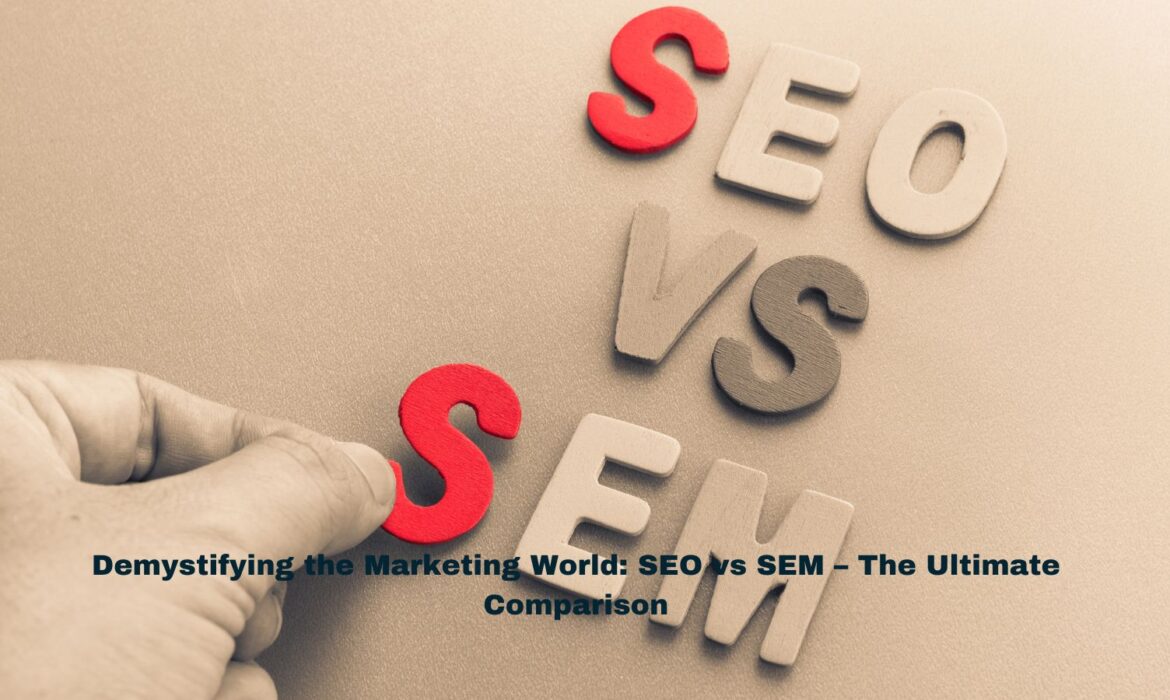
Understanding SEO and SEM
When it comes to marketing your website online, two terms you’ll frequently encounter are SEO and SEM. As they are often used interchangeably, it’s essential to understand the distinction between these two strategies. So, let’s delve into defining what SEO and SEM mean.
Defining SEO
SEO, or Search Engine Optimization, focuses on optimizing a website’s content, structure, and technical elements to improve its visibility in organic search engine results. The objective of SEO is to enhance the website’s rankings, thereby driving more traffic and potential customers to the site (Optimizely).
SEO is a long-term strategy that requires ongoing effort. This includes keyword research, creating high-quality content, optimizing website speed, ensuring mobile-friendliness, improving user experience, building backlinks, and more. While it can take some time to see results, the benefits of a well-executed SEO strategy can be long-lasting, providing a continuous source of free organic traffic.
Defining SEM
On the other hand, SEM, or Search Engine Marketing, involves paid advertising to enhance a website’s visibility in the search engine results pages (SERPs). This strategy can provide immediate results through paid advertising.
SEM usually refers to pay-per-click (PPC) advertising, where advertisers pay a fee each time their ad is clicked on. Popular SEM platforms include Google Ads and Bing Ads. With SEM, you can target specific keywords, demographics, and geographic locations, giving you control over who sees your ads.
While SEM requires a budget for ad spend, it can be particularly effective for driving immediate traffic and increasing brand visibility. It’s often used for specific campaigns, product launches, or when a business wants to quickly increase its online presence.
Remember, both SEO and SEM are crucial components of online marketing. While they involve different methodologies and produce different results, they both aim to increase the visibility of your website in search engine results. Understanding the nuances of ‘seo vs sem’ is essential for devising a holistic marketing strategy that harnesses the best of both worlds.
The Role of SEO
In the realm of digital marketing, understanding the role of Search Engine Optimization (SEO) is crucial. Let’s delve into the importance of SEO and explore some common strategies and techniques used in this field.
Importance of SEO
SEO plays an integral role in enhancing a website’s visibility and rankings in organic search results. Organic search results are the unpaid listings that appear in search engine results pages. When a website is optimized effectively, it shows up higher in these organic search results, leading to increased visibility and potentially more traffic.
The primary focus of SEO is to optimize a website’s content, structure, and technical elements, thereby improving organic search visibility (Optimizely). Unlike Search Engine Marketing (SEM), which can provide immediate results through paid advertising, SEO is a long-term strategy that focuses on organic search results. It involves a sustained effort over time, but the results can be highly rewarding, leading to steady, free traffic over the long term.
SEO Strategies and Techniques
Several strategies and techniques fall under the umbrella of SEO, and these can be broadly categorized into on-page and off-page elements.
On-page SEO involves optimizing the content and HTML source code of a page. This can include optimizing image alt text and title tags, creating unique and informative content, and ensuring that your website is user-friendly and easy to navigate.
Off-page SEO, on the other hand, refers to actions taken outside of your own website to impact your rankings within search engine results pages (SERPs). This includes strategies like backlinking and guest blogging, which can help to enhance the reputation and visibility of your website.
Search engines are increasingly ranking content based on the information provided to users and the user experience, rather than solely relying on keyword research and implementation. This underscores the importance of creating data-driven, fresh, unique, and informative content for SEO (BrightEdge).
Here’s a brief overview of some common SEO strategies:
-
Keyword optimization: This involves identifying and using relevant keywords in your website’s content to improve its visibility in search results.
-
Content creation: Regularly creating unique, high-quality content that provides value to your audience can significantly improve your SEO.
-
Link building: This involves getting other websites to link back to your website, which can enhance your site’s visibility and reputation.
-
Technical SEO: This includes optimizing your website’s structure and code to make it easier for search engines to crawl and index your site.
Remember, the goal of SEO isn’t just to drive more traffic to your site, but to attract high-quality traffic. This means attracting visitors who are genuinely interested in the products or services you offer and are more likely to convert into leads or customers. By understanding and implementing effective SEO strategies, you can significantly enhance the visibility and success of your website.
The Role of SEM
As we delve deeper into our exploration of SEO vs SEM, it’s crucial to understand the role of Search Engine Marketing (SEM) in shaping your business’s online presence.
Importance of SEM
SEM is a paid strategy that involves advertising to increase a website’s visibility in search engine results pages (SERPs). Unlike SEO, SEM provides immediate results, making it a popular choice for businesses looking for quick visibility. According to BrightEdge, 93% of digital marketers invest in paid ads, underscoring the importance of SEM in today’s digital marketing landscape.
SEM not only includes organic search results but also paid search results, which are the sponsored listings that appear in SERPs (Mailchimp). This blend of organic and paid strategies can help businesses reach their target audience quickly and effectively, making it a critical component in any comprehensive digital marketing strategy.
SEM Strategies and Techniques
The core of SEM revolves around paid search advertising. This involves platforms like Google Ads and Bing Ads, which allow businesses to bid on keywords and display ads to users actively searching for products or services related to those keywords (Mailchimp).
Well-executed SEM can help a business achieve top rankings and bring in targeted traffic to their website. It also provides a direct way to measure return on investment (ROI) (Digital Marketing Institute).
SEM strategies can be broken down in various ways, including:
- Paid Search Advertising: This involves creating ads that appear in search engine results when users search for specific keywords. Here’s where Google Ads and Bing Ads come into play.
- Local Search Ads: These are ads that appear when users conduct local searches. It’s a critical component of local search marketing.
- Shopping Ads: These ads often include a photo of the product, a title, price, store name, and more. They can appear in general Google search results or under the “shopping” tab.
However, SEM requires special knowledge and tools, and it may be necessary to hire a web marketing expert to execute successful ad campaigns. Check out our guide on SEM strategies and SEM best practices to learn more about how you can optimize your SEM efforts.
In our comparison of SEO vs SEM, it’s essential to remember that while both have their unique benefits, they can often work best when implemented together. Stay tuned as we dive deeper into this comparison in the coming sections.
Comparing SEO and SEM
When it comes to digital marketing strategies, the comparison between SEO (Search Engine Optimization) and SEM (Search Engine Marketing) often arises. Both of these strategies aim to increase a website’s visibility in search engine results pages (SERPs), but they do so in different ways. Let’s delve into their differences in terms of immediate vs. long-term results and organic vs. paid traffic.
Immediate vs. Long-Term Results
One of the key differences between SEO and SEM revolves around the time frame for results. SEO is a long-term strategy that focuses on organic search results. It requires consistent effort and patience, as it takes time for search engines to crawl and index a website’s pages (SEMrush).
On the other hand, SEM is a paid strategy that has an immediate impact. It involves bidding on keywords to display ads at the top of SERPs, providing immediate results. As reported by BrightEdge, 93% of digital marketers are investing in paid ads, highlighting the growing popularity of this immediate-result strategy.
Organic vs. Paid Traffic
Another key distinction between SEO and SEM relates to the type of traffic they generate. SEO focuses on improving a website’s organic (unpaid) traffic. This traffic comes from users finding a website after conducting a search on search engines like Google or Bing.
In contrast, SEM refers to paid search advertising. It targets specific keywords and demographics, displaying ads to users who are actively searching for products or services related to those keywords. This paid approach allows businesses to reach their target audiences more effectively, but it does come at a cost.
In conclusion, both SEO and SEM play crucial roles in digital marketing. While SEO focuses on long-term organic growth, SEM provides more immediate results through paid advertising. Both strategies can be employed in tandem to maximize a website’s visibility in SERPs. For more information on these strategies, check out my articles on SEO and SEM.
Integrating SEO and SEM
While SEO and SEM can be viewed as separate strategies, it’s important to note that they are not mutually exclusive. In fact, integrating SEO and SEM can lead to a robust and comprehensive marketing strategy that maximizes visibility and effectiveness.
Complementary Strategies
SEO and SEM can be complementary strategies. SEO serves as the foundation for SEM, and having an SEO-friendly website increases the chances of success for SEM campaigns. For instance, prioritizing a PPC (pay-per-click) campaign can be beneficial for newer websites while waiting for SEO rankings to establish.
SEO focuses on optimizing a website’s content, structure, and technical elements to improve organic search visibility and rankings. This includes both on-page and off-page elements, such as optimizing image alt text and title tags, backlinking, and guest blogging. Combining these SEO strategies increases the opportunity for ranked pages (BrightEdge).
On the other hand, SEM involves paid advertising, such as Google Ads or Bing Ads, to increase a website’s visibility in search engine results pages (SERPs). SEM can provide more immediate results and can be used to target specific keywords and demographics, offering a strategic advantage in highly competitive markets (Mailchimp).
Balancing SEO and SEM
While it’s clear that both SEO and SEM can contribute to a successful marketing campaign, the challenge lies in finding the right balance between the two. The choice between SEO and SEM depends on various factors such as the goals, budget, and timeline of a marketing campaign.
For a long-term and cost-effective strategy, investing in SEO is crucial. SEO requires consistent effort and ongoing optimization to maintain and improve rankings in search engine results. On the other hand, if immediate results or targeting specific demographics is a priority, investing more in SEM strategies like PPC advertising might be more beneficial.
However, it’s often recommended to combine the two approaches for maximum visibility and effectiveness (SEMrush). For instance, while waiting for the SEO efforts to start showing results, running SEM campaigns can help a website gain visibility among its target audience.
Ultimately, the integration of SEO and SEM not only contributes to the overall success of a search engine marketing campaign but also ensures a well-rounded and effective approach to achieving the desired marketing goals.
Choosing between SEO and SEM
As we delve deeper into the world of search engine marketing, a common question that arises is whether to focus on SEO (Search Engine Optimization) or SEM (Search Engine Marketing). It’s a crucial decision that can significantly impact your online visibility, website traffic, and ultimately, the success of your digital marketing efforts.
Factors to Consider
The choice between SEO and SEM depends on various factors such as the goals, budget, and timeline of a marketing campaign. Both SEO and SEM are vital components of a comprehensive search engine marketing strategy, and their significance cannot be overstated.
SEO is a long-term strategy that helps to increase organic traffic and establish a strong online presence. It involves optimizing your website to rank higher in search engine results, thereby attracting more visitors. SEO is cost-effective, but it requires time and patience to see significant results.
On the other hand, SEM provides instant visibility and can drive targeted traffic to your website. Using platforms like Google Ads and Bing Ads, you can display your advertisements to users who are actively searching for keywords related to your business. Although SEM involves a cost for each click (pay-per-click or PPC), it can deliver immediate results and is particularly useful for time-sensitive campaigns or promotions.
Making an Informed Decision
In my view, SEO and SEM are not mutually exclusive, but rather complementary strategies. SEO is the foundation for SEM, and having an SEO-friendly website increases the chances of success for SEM campaigns. Prioritizing a PPC campaign can be beneficial for newer websites while waiting for SEO rankings to establish (Digital Marketing Institute).
It is often recommended to combine the two approaches for maximum visibility and effectiveness (SEMrush). You can start by building a strong SEO foundation, then supplement your efforts with targeted SEM campaigns as needed.
Remember that the ultimate goal is to attract and retain visitors to your website, whether through organic search results (SEO) or paid advertisements (SEM). By understanding the strengths and limitations of each approach, you can make an informed decision that aligns with your business objectives.
For further guidance, check out our articles on SEM strategies and SEM best practices. We also provide resources on local search marketing and SEM for small businesses, which can help you tailor your SEO and SEM efforts to your specific needs.
- Boost Your Business: Expert Google My Business Ranking Tipsby Freelancertamal●March 1, 2024
- Strategies to Improve Your Website Visibilityby Freelancertamal●February 18, 2024
- Unlocking Success: The Art of Freelance Project Managementby Freelancertamal●January 4, 2024
- Mastering Email Marketing in Rangpur: Secrets to Digital Triumphby Freelancertamal●January 4, 2024










